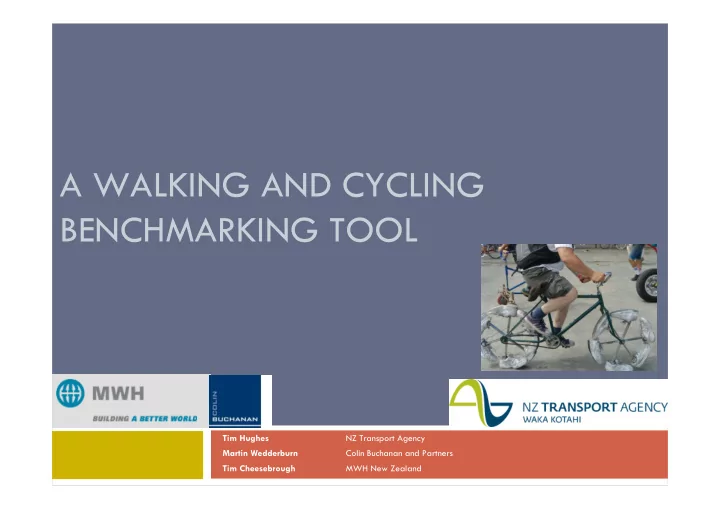

A WALKING AND CYCLING BENCHMARKING TOOL Tim Hughes NZ Transport Agency Martin Wedderburn Colin Buchanan and Partners Tim Cheesebrough MWH New Zealand
A New Walking and Cycling Benchmarking Tool for NZ Background to development of the tool International benchmarking examples studied by MWH NZ and Colin Buchanan and Partners (UK) Principles of the tool required for New Zealand Adapting the European Foundation for Quality Management Model An assessment matrix methodology How the new tool might be used across NZ Update on current status of the project Upcoming regional stakeholder workshops
What is Benchmarking? Benchmarking of local authority cycling and walking practice was seen as a key enabler of best practice in support of NZ Walking and Cycling Strategy Chief purpose ‐ to help all local authorities to improve services across a range of activities that support cycling and walking Most important objective is to help identify and share best practice
Benchmarking Principles… Uses performance measurement of an authority’s: institutional framework and resources (the enablers) its resulting activities cycling and walking outcomes ultimate “impacts” – such as social, environmental, economic, quality of life effects from active travel support …as a common yardstick to identify and compare best practice – both nationally and internationally
Benchmarking Principles… Not intended to create performance “league tables”, except where of help to authorities seeking to maximise their own value for money and delivery When working well, identifies genuinely adaptable best practice in a supportive environment , with the help of NZTA and a peer group of like minded authorities
How Does Successful Benchmarking Work? The Process Self Analysis Identifying best practices that might be adaptable Analysing performance and delivery differences across authorities Implementing findings locally to improve effectiveness and value for money of authority’s approaches The Results Narrowed performance gaps across sector Tangible performance improvements and improved value for money for each contributing authority
International Examples Studied A large number of completed and ongoing benchmarking processes used around the globe studied, including : Velo Info European Bicycle Policy Audit (BYPAD) English Regions Cycling Development Team (ERCDT) (UK) CTC (Cyclists Touring Club) Local Authority Benchmarking Project (UK) Dutch Cycle Balance Bicycle Federation of Australia Copenhagen Bicycle Account US Alliance for Biking and Walking (formerly the Thunderhead Alliance) Walk 21 Dimensions / Comparators
Comparing the approaches… Direction of travel for benchmarking practices - in monitoring output, outcome and impact performance
A base Model for Business Excellence Enablers Results Key Perf orm ance People People Result s Leadership Processes Result s Policy and Cust om er St rat egy Result s Part nerships Societ y Result s and Resources Innovation and Learning European Foundation for Quality Management (EFQM) Model
International objective “ Establishing a set of international guidelines for the collection, analysis and dissemination of quantitative and qualitative techniques for measuring walking.” (WALK21 conference conclusions Melbourne 2006)
International Walk 21 conference workshops Website: www.measuring ‐ walking.org/ Walking benchmarking assessment model Making Walking Count resident surveys
USA Alliance for Biking and Walking Levels of walking / cycling Safety Funding Education Advocacy Public health
USA Alliance for Biking and Walking
Copenhagen Bicycle Account
Copenhagen Bicycle Account Cycle flows Infrastructure Satisfaction Safety Funding Health Perceptions of other road users
Making Walking Count Walking activity 1. Activity in the public realm 2. Local accessibility 3. Motivations 4. Barriers 5. Perception of the walking 6. environment Measures to improve the 7. walking environment Transport spending 8. priorities
Time spent walking
Children walk to primary school unaccompanied?
Time spent in public space
Measuring Walking Project (Walk 21) New 2010 Assessment Model for Measuring Walking Courtesy of Urban Mobility Research, Switzerland (Daniel Sauter)
Latest 2010 Cycling Model Adaptation (to closely accord with new Walk 21 model)
A two stage benchmarking process for NZ… Stage A - Self Assessment Collection of primarily quantitative / factual information Maximum use of existing data sets – eg LTCCP published programmes, performance results – alignment to MoT TMIF(2) Authority determines for itself where it currently stands Stage B - Peer Group Independent Assessments Facilitated visits by and to peer group authorities Focus on qualitative assessment: common success factors, sharing experience, finding adaptable best practice - policy and strategy into practice
Please contact us: Tim Hughes NZ Transport Agency (Christchurch) tim.hughes@nzta.govt.nz Martin Wedderburn, Colin Buchanan (UK) martin.wedderburn@cbuchanan.co.uk Tim Cheesebrough MWH NZ tim.l.cheesebrough@nz.mwhglobal.com
Recommend
More recommend